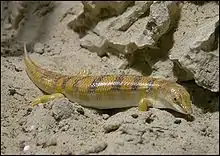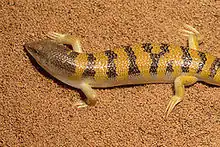Scincus scincus
The common sandfish (Scincus scincus), also commonly known as the common skink, is a species of skink that burrows into the sand and swims[1] through it. It is native to north Africa and southwestern Asia, but is also kept as a pet elsewhere.[2]
| Common skink | |
|---|---|
 | |
| Scientific classification | |
| Kingdom: | Animalia |
| Phylum: | Chordata |
| Class: | Reptilia |
| Order: | Squamata |
| Family: | Scincidae |
| Genus: | Scincus |
| Species: | S. scincus |
| Binomial name | |
| Scincus scincus | |
Description
The name Algerian sandfish originated because of its ability to move through sand as if it were swimming. Adult common skinks usually reach about 20 cm (8 inches) in length, including the short tail.
The common skink has developed a peculiar surprise way of dealing with the desert heat: it can dive into soft sand. It does this to prevent overheating (as it is cold-blooded) and whenever it feels threatened, especially by its arch-nemesis: the devil-headed Saharan snake.
This skink has a long, wedge-shaped snout with a countersunk lower jaw, shaped much like a basket. Its compact, tapered body is covered with smooth, shiny scales that may appear oily to the untrained eye, and its legs are short and sturdy with long, flattened and fringed shovel-like feet. The tail is short, tapering to a fine point. The coloration of this species is considered attractive, being yellow-caramel with brown-black cross bands. This lizard also has bead-like eyes so it can close them to keep sand out of its eyes. Similarly, its nostrils are very small to keep all of the sand out of its nose and lungs.
X-ray imaging[3] has demonstrated the lizard swims within sand using an undulatory gait with its limbs tucked against its sides rather than use its limbs as paddles [4] to propel itself forward. Subsequent studies of the mathematics of sandfish sand-swimming,[5] using robotic models,[6] and electromyography[7] show that the sandfish uses the optimum waveform to move through the sand with minimal energetic cost, given its anatomy.
To further support their title as a "sand-fish," these lizards are able to breathe even when completely submerged in the desert sand.[8] They breathe the tiny pockets of air between grains of sand, and a specially-formed respiratory tract catches inhaled particles before they reach the lungs. These particles are then expelled via sneezing.
Range
Species in the Scincus genus are distributed over an extensive belt of desert from the west coast of Africa, through the Sahara and into Arabia.[9]
Diet

The sandfish skink is an insectivore. It can detect vibrations that nearby insects create while moving,[10] using those vibrations to locate, ambush, and consume them.
Captivity
S. scincus is relatively simple to care for as a pet,[11] but rarely breeds in captivity, so most animals in pet trade are wild-caught.
References
- Fountain, Henry (2009-07-21). "A Saharan Lizard Is a Sand Swimmer". The New York Times. Retrieved 2010-05-23.
- http://science.jrank.org/pages/5956/Sandfish.html
- Maladen, R. D.; Ding, Y.; Li, C.; Goldman, D. I. (2009). "Undulatory Swimming in Sand: Subsurface Locomotion of the Sandfish Lizard" (PDF). Science. 325 (5938): 314–318. Bibcode:2009Sci...325..314M. doi:10.1126/science.1172490. PMID 19608917. S2CID 15509585.
- Baumgartner, Werner; Fidler, Florian; Weth, Agnes; Habbecke, Martin; Jakob, Peter; Butenweg, Christoph; Böhme, Wolfgang (2008). "Investigating the Locomotion of the Sandfish in Desert Sand Using NMR-Imaging". PLOS ONE. 3 (10): e3309. Bibcode:2008PLoSO...3.3309B. doi:10.1371/journal.pone.0003309. PMC 2561000. PMID 18836551.
- Ding, Yang; Sharpe, Sarah S.; Masse, Andrew; Goldman, Daniel I. (2012). "Mechanics of Undulatory Swimming in a Frictional Fluid". PLOS Computational Biology. 8 (12): e1002810. Bibcode:2012PLSCB...8E2810D. doi:10.1371/journal.pcbi.1002810. PMC 3531286. PMID 23300407.
- Maladen, R. D.; Ding, Y.; Umbanhowar, P. B.; Kamor, A.; Goldman, D. I. (2011). "Mechanical models of sandfish locomotion reveal principles of high performance subsurface sand-swimming". Journal of the Royal Society Interface. 8 (62): 1332–1345. doi:10.1098/rsif.2010.0678. PMC 3140717. PMID 21378020.
- Sharpe, S. S.; Ding, Y.; Goldman, D. I. (2012). "Environmental interaction influences muscle activation strategy during sand-swimming in the sandfish lizard Scincus scincus". Journal of Experimental Biology. 216 (2): 260–274. doi:10.1242/jeb.070482. PMID 23255193.
- Stadler, Anna T.; Vihar, Boštjan; Günther, Mathias; Huemer, Michaela; Riedl, Martin; Shamiyeh, Stephanie; Mayrhofer, Bernhard; Böhme, Wolfgang; Baumgartner, Werner (2016-11-15). "Adaptation to life in aeolian sand: how the sandfish lizard, Scincus scincus, prevents sand particles from entering its lungs". Journal of Experimental Biology. 219 (22): 3597–3604. doi:10.1242/jeb.138107. ISSN 0022-0949. PMC 5117194. PMID 27852763.
- Baumgartner, Werner; Fidler, Florian; Weth, Agnes; Habbecke, Martin; Jakob, Peter; Butenweg, Christoph; Böhme, Wolfgang (2008). "Investigating the Locomotion of the Sandfish in Desert Sand Using NMR-Imaging". PLOS ONE. 3 (10): e3309. Bibcode:2008PLoSO...3.3309B. doi:10.1371/journal.pone.0003309. PMC 2561000. PMID 18836551.
- Hetherington, Thomas E. (1989-02-01). "Use of vibratory cues for detection of insect prey by the sandswimming lizard Scincus scincus". Animal Behaviour. 37: 290–297. doi:10.1016/0003-3472(89)90118-8. ISSN 0003-3472.
- Healey, Mariah. "Sandfish Care Guide". ReptiFiles. Retrieved 2020-06-06.
Further reading
External links
| Wikimedia Commons has media related to Scincus scincus. |